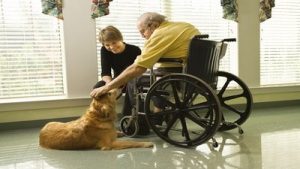Level 3 Diploma in Animal Assisted Intervention
The Animal Assisted Intervention Course is of benefit to those wanting to work in the field of Animal Assisted Intervention.
- Animal Assisted Intervention (AAI) is a type of therapy that involves animals as a form of treatment. The goal of AAI is to improve a patient’s social, emotional, or cognitive functioning.
- Animal Assisted Intervention services can help children, adolescents, adults and older people with mental health needs, physical or learning disabilities, to achieve increased health, wellbeing and quality of life.
- Animal Assisted Intervention animals are selected by trained staff on temperament grounds to provide therapeutic visits to hospitals, nursing homes, hospices, special needs schools, prisons, etc.
- A career in this type of work also involves the care and welfare of the animals working in therapy.

Learn about the training and selection methods used for different types of therapy animals and the protocols that are critically important to ensuring the welfare of therapy animals.
Level 3 Diploma in Animal Assisted Intervention
Unit Summary (262 GLH)
Unit 1
History of Animal Assisted Intervention
This unit gives the learner a background of the human-animal bond, and how this relates to providing Animal Assisted Intervention.
Students will gain an understanding of Animal Assisted Intervention and how Animal Assisted Intervention can be used in practice.
Learn about the history and science behind Animal Assisted Intervention.
Unit 2
The Use of Animal Assisted Intervention
This unit enables learners to understand how Animal Assisted Intervention is used and the limits and contraindications of providing Animal Assisted Intervention
Students will explore the positive effects of Animal Assisted Intervention including:
- Learn how Animal Assisted Intervention can be used in the rehabilitation of offenders
- Understand how Animal Assisted Therapy can be used in therapy for child and adult disease and disabilities
- Understand how Animal Assisted Intervention and Animal Assisted Therapy can be used with children and the elderly.
Unit 3
Legal responsibilities in animal assisted intervention
In the unit, students will gather an understanding of the legalities of those involved with Animal Assisted Intervention
This unit explores:
-
- The safeguarding of service users/clients
- Lone working regulations
- The various insurances relate
Unit 4
Animal Assisted Intervention Roles
Students will explore the roles of those within Animal Assisted Intervention organisations.
- Learn about Animal Assisted Intervention standard
- Understand the role of handler within organisations and the assessment process for Animal-Assisted Intervention volunteer dogs
Learn about various disabilities – both physical and mental, and the key awareness of working with animals
Students will gain an understanding of disability awareness when working with animals, including how animals may affect a client group and vice-versa.
Unit 5
Client and Animal Matching in Animal Assisted Intervention
Explore the processes of matching of clients to personnel and animals, and the importance and process of consent.
Unit 6
Selection, Training and Welfare of Animal Assisted Intervention Animals
Students undertaking this unit will investigate the correct selection methods for finding suitable animals, how to train animals using positive, force-free methods, and the identification of behaviour and body language.
- Explore the selection and training process of Animal Assisted Intervention animals
- Learn how to identify animals that are not suitable for Animal-Assisted Intervention
- Understand the welfare needs of Animal Assisted Intervention animals
- Learn about normal animal behaviour and how to identify the signs of stress including how to minimise stress during transportation
This unit also includes information about the animal and human body language.
Unit 7
Disabilities and Animal Assisted Intervention
Learn about various disabilities – both physical and mental, and the key awareness of working with animals
Students will gain an understanding of disability awareness when working with animals, including how animals may affect a client group and vice-versa.
Unit 8
Skills for Working in Animal Assisted Intervention
Learn about the essential additional skills needed for various Animal Assisted Intervention roles and how to organize a successful Animal Assisted Intervention session.
Unit 9
Practical Training in Animal Assisted Intervention
You will learn skills that will enable you to demonstrate assessing and training of dogs for animal assisted intervention work. Learners will also demonstrate how to assess the appropriate method of training for an individual dog and recognise subtle body language
As part of this qualification, we include online Webinars.
Online training negates the need for travel or overnight accommodation in many cases and also allows access to overseas students. The teaching for this unit ensures your learning meets the assessment criteria for the qualification
Animal Assisted Intervention for Children and Adults

Interventions vary widely, from long-term arrangements in which patients adopt pets to short-term interactions between patients and a trained animal in structured activities. Learn how Animal Assisted Intervention and Animal Assisted Therapy can be used to stimulate the natural development of children and provide therapeutic care for the elderly.
Animal Assisted Intervention can also be used in the management of both developmental conditions in children and in the rehabilitation of offenders, as well as providing therapy for child and adult disease and disabilities.

*You will have access to the course for 12 months only. You can purchase course extensions.
We offer a selection of accredited and employer recognised courses specifically designed for careers working with animals.
If you have any questions about our courses, please contact us.
We’ve assisted many people to achieve their goal to work with animals. Read more about our 5-star reviews and student success stories.
Gain relevant training to achieve your goal to work with animals.


 The Animal Assisted Intervention Course is of benefit to those wanting to work in the field of Animal Assisted Intervention.
The Animal Assisted Intervention Course is of benefit to those wanting to work in the field of Animal Assisted Intervention.